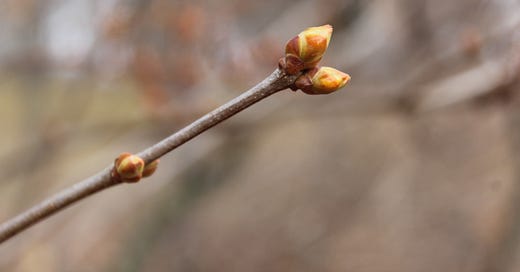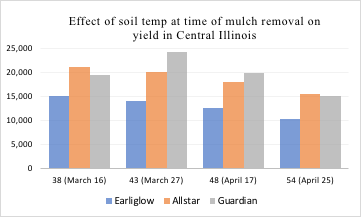When should you remove straw this year?
Back in the 80’s, when land grant universities still focused on applied research, the University of Illinois did a small study on the best time to remove straw mulch from a strawberry field at a plot on the Urbana-Champagne campus. They removed straw at four different soil temperatures to see which removal time had the highest yields. The four soil temperatures were 38, 43, 48 and 54 F. The highest yields were in the fields uncovered at 38 and 43F. Earliglow and Allstar had the same yields at both temperatures, but the variety Guardian had a significantly higher yield when uncovered at 43. Plants uncovered at 54F lost a third of their crop compared to the earlier plants.* Because of those results, extension faculty have long recommended that growers uncover their berries at 40 F.
When helping Minnesota growers, I had to adjust the results of the Illinois study to local conditions. Champagne-Urbana is a long ways from anywhere in this state. In the Illinois study, the soil temperature of 38 was reached on March 16, 43 was on March 27, 48 was on April 17 and 54 was on April 25, showing that the soil gradually warmed in a predictable trend. I can guarantee that most of you will have fields on April 7 where the temperature is 38 in one section and 54 in another section. When I visit strawberry farms before uncovering, I regularly saw fields where one section was frozen and another section was above 45F.
I will get back to the Illinois study, but first, I would like to discuss the science of what happens if you remove the straw too late, and discuss the popular Facebook videos that combine two topics that Montanans can never get enough of: bears and skiing. There have been several videos of bears chasing skiers somewhere in Eastern Europe. While most people worry about the skiers being harmed, there is also a concern for the bears. When a bear emerges from its den in the spring, it only has a small amount of energy, and if the bear expends its energy chasing skiers who tend to have a low fat content instead of restoring its fat reserves eating decaying deer, that bear could become seriously weak and vulnerable to other stresses like cold and disease.
Strawberry plants also store energy for the winter, but instead of fat, they create starch reserves in the crown. In the spring, the plant starts to convert the starch into sugar, which it then uses to make new leaves. Like a bear emerging from hibernation, your strawberry plants have limited resources before they start “feeding” in the spring. For a strawberry, “feeding” means new leaves are photosynthesizing. There is a transition period between when the plant is entirely dependent on the stored reserves to when the plant can rely entirely on current photosynthesis. In spite of the small size of a strawberry crown, there are enough reserves in a healthy plant to form about 4 large, yellow leaves with no new photosynthesis.
If you were raising bears, you would feed the bear right away rather than let it chase skiers. As a strawberry grower, you want the leaves to photosynthesize as soon as possible. If a plant puts all its stored energy into making leaves that don’t photosynthesize, it will have little energy to energy to develop flower buds. Strawberries are an unusual type of fruit, because the size of the berry is largely determined by the number of seeds, and the number of seeds is determined both as the flower buds grow in late fall and in early spring. If the plant is putting all its energy into making yellow leaves, there will be little energy left for the flower buds.
The diversion of energy into the leaves instead of the flower buds explains the yield losses in the Illinois study. The number of flower buds was determined in the fall, but plants trying to grow beneath the straw had smaller fruit, which accounted for the 30% loss in yield. Unfortunately, the Illinois researchers did not look to see how much strawberry plants were growing beneath the straw.
Guidelines for straw removal
The fast warm-up. If the soil temperature goes from 30 to 45 in one week, you don’t need to remove straw right away. During a fast warm up, the plants will take a week before they start growing. The researchers in Illinois did not mention how time makes a difference. There was a three week interval between the 43 and 48 degree temperatures. Plants grow slowly at 43, but over a three week time period, it will be pushing more and more.
Lilac buds. Since time immemorial, people looked to phenology of different species to guide their decisions. The Ojibway knew that when the spring peepers started calling, the maple sap stopped flowing, a relationship I have corroborated. Early twentieth century farmers planted corn when the oak leaves were the size of a mouse’s ear. Dr. David Wildung at the University of Minnesota looked for a similar event to time straw removal. He found a strong relationship between to lilac buds began swelling and straw removal. My recommendation is to look at the lilacs and then dig under the straw to look for new growth in the strawberries.
Swollen lilac buds in Frazee, Minnesota, March 27, 2021
New growth. Try to time your straw removal when the first leaves are emerging from the crown and have not unfolded. When the leaves are big enough to be torn off during straw removal, it’s too late. Some guidelines say to remove straw when a quarter of the plants start growing.
Weather reports. Delay removing straw if daytime temperatures are above 80 and if predicted nighttime temperatures are below 30. Strawberry leaves are remarkably frost resistant after they acclimate. The strawberry plants are like us when someone rips the blankets off on a cold night. A growing strawberry leaf that was just uncovered could be killed at temperatures of about 30. A few days later that leaf will survive temperatures down to about 20.
Keeping straw on to delay bloom. Straw mulch will delay bloom by keeping the soil from warming too quickly in the spring. Strawberry plants with no straw will bloom and ripen about 2 weeks before plants with a good straw cover. A strawberry field that is mulched in early spring will ripen nearly a week before a field that is mulched in November. Once the soil temperature rises to the mid 40’s, the plants will grow whether there is straw or not. If you keep the straw on after the plants grow, you don’t delay bloom by that much. In the Illinois study, Allstar and Guardian plants with straw removed on March 16 ripened two days earlier than plants with straw removed on April 25.
Putting it all together in 2021
2021 appears to be one of those years when there is no ideal time to remove straw. The lilac buds are swelling at my house near Detroit Lakes. I checked several strawberry fields near St. Cloud, and about a quarter of the strawberry plants were growing even under thick straw. I hesitate to tell people to remove straw as soon as possible, because temperatures on Tuesday are supposed to tumble to the mid teens in some areas. If you were thinking about uncovering on Sunday or Monday, you should wait until after the brief cold snap. Some growers use rotary rakes or side delivery rakes pulled by tractors. In many cases, those rakes do an incomplete job, and the grower has to come back and remove the straw with pitchforks and rakes. It’s not a bad idea to remove straw in two steps. One to loosen the straw, before the cold, and a second step to completely expose the plants after the cold snap.
Strawberry leaf emerging from straw, March 25, 2021. Not too late to remove straw
A number of older growers in Minnesota would wait until after the full moon, believing that cold temperatures were most likely during a full moon. The full moon is on Sunday, and it may be a good idea to wait.
*Data from Otterbacher and Skirven. 1990 Illinois Small Fruit, Strawberry and Amateur Winemaker Schools.





